Agency and Structure in Shipbuilding: Practice and Social Learning Perspectives
Abstract
1. Introduction
2. A Summary of Practice Theory
3. Social Learning Theory and Communities of Practice
4. The Chaîne Opératoire or Operational Process
5. Applying Practice and Social Learning Theory in Archaeology
6. The Medieval and Early Modern Mediterranean: A First Case Study
6.1. Conception of the Medieval Shipbuilding Communities and Their Ships
6.2. Mediterranean Ship Construction
6.3. Mediterranean Communities of Practice
7. Late 17th-Century Shipbuilding in France: A Second Case Study on Social Organization and Framing Pattern
7.1. Shipwrights Corporations as Communities of Practices
7.2. Methodology
7.3. Results
7.3.1. Single Framing Pattern
7.3.2. Double Framing Pattern
7.3.3. The Case of Coulomb’s Manuscript
8. Conclusions
Author Contributions
Funding
Acknowledgments
Conflicts of Interest
References
- Bourdieu, P. Outline of a Theory of Practice; Cambridge University Press: Cambridge, UK, 1977; ISBN 978-0521231644. [Google Scholar]
- Bourdieu, P. Le Sens Pratique; Les éditions de Minuit: Paris, France, 1980; ISBN 978-2707302984. [Google Scholar]
- Dobres, M.-A.; Robb, J. Agency in Archaeology. Paradigm or Platitude? In Agency in archaeology; Dobres, M.-A., Robb, J., Eds.; Routledge: London, UK, 2000; pp. 3–17. [Google Scholar]
- Dornan, J. Agency and Archaeology: Past, Present, and Future Directions. J. Archaeol. Method Theory 2002, 9, 303–329. [Google Scholar] [CrossRef]
- Giddens, A. The Constitution of Society; University of California Press: Berkeley, CA, USA, 1984; ISBN 978-0-520-05292-5. [Google Scholar]
- Bandura, A. Social Learning Theory; Prentice-Hall: Englewood Cliffs, NJ, USA, 1977; ISBN 013816751. [Google Scholar]
- Bandura, A. Social Cognitive Theory: An Agentic Perspective. Annu. Rev. Psychol. 2001, 52, 1–26. [Google Scholar] [CrossRef] [PubMed]
- Bandura, A. Social Cognitive Theory in Cultural Context. Appl. Psychol. Int. Rev. 2002, 51, 269–290. [Google Scholar] [CrossRef]
- Bandura, A. Toward a Psychology of Human Agency. Perspect. Psychol. Sci. 2006, 1, 164–180. [Google Scholar] [CrossRef] [PubMed]
- Lave, J.; Wenger, E. Situated Learning: Legitimate Peripheral Participation; Cambridge University Press: Cambridge, UK, 1991; ISBN 978-0-521-41308-4. [Google Scholar]
- Wenger, E. Communities of Practice: Learning, Meaning, and Identity; Cambridge University Press: Cambridge, UK, 1998; ISBN 978-0-521-43017-3. [Google Scholar]
- Wenger, E. Communities of Practice and Social Learning Systems: The Career of a Concept. In Social Learning Systems and Communities of Practice; Blackmore, C., Ed.; Springer, London, UK, 2010; pp. 179–198, ISBN 978-1-84996-132-5.
- Haudricourt, A.-G. La Technologie Science Humain. Recherche d’histoire et d’ethnologie Des Techniques; Éditions de la Maison des Sciences de l’Homme: Paris, France, 1987; ISBN 2-7351-0227-0. [Google Scholar]
- Mauss, M. Les Techniques Du Corps. J. Psychol. 1936, 32, 1–18. [Google Scholar]
- Leroi-Gourhan, A. Le Geste et La Parole; Albin Michel: Paris, France, 1964; ISBN 978-2-226-01728-4. [Google Scholar]
- Lemonnier, P. Technique (Système). In Dictionnaire de l’ethnologie et de l’anthropologie; Bonte, P., Izard, M., Eds.; Presses Universitaires de France: Paris, France, 1991; pp. 697–698. ISBN 978-2-13-058426-1. [Google Scholar]
- Dobres, M.A. Technology and Social Agency: Outlining a Practice Framework for Archaeology; Blackwell Publishers: Oxford, UK, 1995; ISBN 978157718124. [Google Scholar]
- Hensler, R. Using Chaîne Opératoire and Communities of Practice to Identify Interaction in the Contact and Mission Periods in Southern Georgia, AD 1540-1715. Southeast. Archaeol. 2020, 39, 109–124. [Google Scholar] [CrossRef]
- Kelly, G. Heterodoxy, Orthodoxy and Communities of Practice: Stone Bead and Ornament Production in Early Historic South India (c. 400 BCE-400 CE). Archaeol. Res. Asia 2016, 6, 30–50. [Google Scholar] [CrossRef]
- Roux, V. Ceramics and Society. A Technological Approach to Archaeological Assemblages; Springer: Cham, Switzerland, 2019; ISBN 978-3-030-03972-1. [Google Scholar]
- Cameron, C.M. Structure Abandonment in Villages. In Archaeological Method and Theory; Schiffer, M.B., Ed.; University of Arizona Press: Tucson, AZ, USA, 1991; Volume 3, pp. 155–194. ISBN 978-0-8165-1239-3. [Google Scholar]
- Lemonnier, P. La Description Des Chaînes Opératoires: Contributions à l’analyse Des Systèmes Techniques. Tech. Cult. 1976, 1, 101–150. [Google Scholar] [CrossRef]
- Pomey, P.; Rieth, E. L’archéologie Navale; Editions Errance: Paris, France, 2005; ISBN 2-87772-301-1. [Google Scholar]
- Pomey, P. Principes et Methodes de Construction En Architecture Navale Antique. Cah. Hist. 1988, 33, 397–412. [Google Scholar]
- Pomey, P. Defining a Ship: Architecture, Function, and Human Space. In The Oxford Handbook of Maritime Archaeology; Catsambis, A., Ford, B., Hamilton, D., Eds.; Oxford University Press: New York, NY, USA, 2011; pp. 25–46. ISBN 978-0-19-537517-6. [Google Scholar]
- Hocker, F. Shipbuilding: Philosophy, Practice, and Research. In The Philosophy of Shipbuilding: Conceptual Approaches to the Study of Wooden Ships; Hocker, F., Ward, C., Eds.; Texas A&M University Press: College Station, TX, USA, 2004; pp. 1–11. ISBN 1-58544-313-1. [Google Scholar]
- Harpster, M. Designing the 9th-Century-AD Vessel from Bozburun, Turkey. Int. J. Naut. Archaeol. 2009, 38, 297–313. [Google Scholar] [CrossRef]
- Worth, J. What’s in a Phase? Disentangling Communities of Practice from Communities of Identity in Southeastern North America. In Forging Southeastern Identities: Social Archaeology, Ethnohistory, and Folklore of the Mississippian to Early Historic South; Waselkov, G., Smith, M., Eds.; University Alabama Press: Tuscaloosa, AL, USA, 2017; pp. 117–156. ISBN 0-8173-1941-7. [Google Scholar]
- Eckert, S. Pottery and Practice: The Expression of Identity at Pottery Mound and Hummingbird Pueblo; University of New Mexico Press: Albuquerque, NM, USA, 2008; ISBN 978-0-8263-3834-1. [Google Scholar]
- Eckert, S. Choosing Clays and Painting Pots in the Fourteenth-Century Zuni Region. In Potters and Communities of Practice: Glaze Paint and Polychrome Pottery in the American Southwest, A.D. 1250 to 1700; Cordell, L., Habicht-Mauche, J., Eds.; University of Arizona Press: Tucson, AZ, USA, 2012; pp. 55–64. ISBN 978-0-8165-2992-6. [Google Scholar]
- Eckert, S. The Dynamic Nature of Cultural Identity during the Fourteenth and Fifteenth Centuries in Central New Mexico. In Archaeology without Borders: Contact, Commerce, and Change in the U.S. Southwest and Northwestern Mexico; Webster, L., McBrinn, M., Eds.; University Press of Colorado: Boulder, CO, USA, 2008; pp. 271–282. ISBN 0-87081-889-9. [Google Scholar]
- Eckert, S.; Schleher, K.; James, W. Communities of Identity, Communities of Practice: Understanding Santa Fe Black-on-White Pottery in the Española Basin of New Mexico. J. Archaeol. Sci. 2015, 63, 1–12. [Google Scholar] [CrossRef]
- Manders, M. In Situ Preservation: ‘The Preferred Option’. Mus. Int. 2008, 60, 31–41. [Google Scholar] [CrossRef]
- Harpster, M. Shipwreck Identity, Methodology, and Nautical Archaeology. J. Archaeol. Method Theory 2013, 20, 588–622. [Google Scholar] [CrossRef]
- Rieth, E. Pour Une Histoire de L’archéologie Navale: Les Bateaux et L’histoire; Classiques Garnier: Paris, France, 2019; ISBN 2-406-08848-0. [Google Scholar]
- Gregory, D. Characterizing the Preservation Potential of Buried Marine Archaeological Sites. Heritage 2020, 3, 838–857. [Google Scholar] [CrossRef]
- Bevan, A. Mediterranean Containerization. Curr. Anthropol. 2014, 55, 387–418. [Google Scholar] [CrossRef]
- Steffy, R. Wooden Ship Building and the Interpretation of Shipwrecks; Texas A&M University Press: College Station, TX, USA, 1994; ISBN 978-1603445207. [Google Scholar]
- van Doorninck, F., Jr. The 4th Century Wreck at Yassi Ada. An Interim Report on the Hull. Int. J. Naut. Archaeol. 1976, 5, 115–131. [Google Scholar] [CrossRef]
- Pulak, C. Mortise-and-Tenon Joints of Bronze Age Seagoing Ships. In Boats, Ships and Shipyards. Proceedings of the Ninth International Symposium on Boat and Ship Archaeology, Venice 2000; Oxbow Books: Oxford, UK, 2003; pp. 28–34. ISBN 1-84217-093-7. [Google Scholar]
- Pomey, P.; Kahanov, Y.; Rieth, E. On the Transition from Shell to Skeleton in Ancient Mediterranean Ship-Construction: Analysis, Problems, and Future Research. Int. J. Naut. Archaeol. 2012, 41, 235–314. [Google Scholar] [CrossRef]
- Kocabas, U. The Old Ships of the New Gate/Yenikapi’nin Eski Gemileri; Ege Yayinlari: Instanbul, Turkey, 2012; Volume 1, ISBN 6055607867. [Google Scholar]
- Rieth, E. Géométrie Des Formes de Carène et Construction «sur Membrure Première» (Ve-XIIe Siecles). Archaeol. Marit. Mediterr. 2008, 5, 45–68. [Google Scholar] [CrossRef]
- Rieth, E. Master Frame and Flat Floor-Timber: An ‘Architectural Signature’ of the Mediterranean Shipyards? Heritage 2021, 4, 2623–2642. [Google Scholar] [CrossRef]
- Bass, G.; Matthews, S.; Steffy, R.; van Doorninck, F., Jr. (Eds.) Serçe Limanı: An Eleventh-Century Shipwreck; Texas A&M University Press: College Station, TX, USA, 2004; Volume 1, ISBN 978-0-89096-947-2. [Google Scholar]
- Pulak, C. Yenikapı Shipwrecks and Byzantine Shipbuilding. In Constantinople Réelle et Imaginaire: Autour de L’Œuvre de Gilbert Dagron; Association des Amis du Centre d’Histoire et Civilisation de Byzance: Paris, France, 2018; pp. 237–295. ISBN 978-2-916716-65-7. [Google Scholar]
- Pomey, P. On the Use of Design in Ancient Mediterranean Ship Construction. In Creating Shapes in Civil and Naval Architecture: A cross-disciplinary comparison; Nowacki, H., Lefèvre, W., Eds.; Brill: Leiden, The Netherlands, 2009; pp. 49–63. ISBN 978-90-474-2691-2. [Google Scholar]
- Basch, L. Construction Privée et Construction d’etat Dans l’Antiquité. In Concevoir et construire les navires: De la tirère au picoteux; Rieth, E., Ed.; Erès: Ramonville-Saint-Agne, France, 1998; pp. 21–48. ISBN 2-86586-600-9. [Google Scholar]
- Rieth, E. Mediterranean Ship Design in the Middle Ages. In The Oxford Handbook of Maritime Archaeology; Catsambis, A., Ford, B., Hamilton, D., Eds.; Oxford University Press: New York, NY, USA, 2011; pp. 406–425. ISBN 978-0-19-537517-6. [Google Scholar]
- Lane, F. Venetian Ships and Shipbuilders of the Renaissance; John Hopkins University Press: Baltimore, MD, USA, 1934. [Google Scholar]
- Lane, F. Venice: A Maritime Republic; John Hopkins University Press: Baltimore, MD, USA, 1973; ISBN 0-8018-1445-6. [Google Scholar]
- de la Croix, D.; Doepke, M.; Mokyr, J. Clans, Guilds, and Markets: Apprenticeship Institutions and Growth in the Preindustrial Economy. Q. J. Econ. 2018, 133, 1–70. [Google Scholar] [CrossRef]
- Ogilvie, S. The European Guilds: An Economic Analysis; Princeton University Press: Princeton, NJ, USA, 2019; ISBN 978-0-691-13754-4. [Google Scholar]
- Fourquin, N. A Medieval Shipbuilding Estimate (C. 1273). Mar. Mirror 1999, 85, 20–29. [Google Scholar] [CrossRef]
- Fourquin, N. Un Devis de Construction Navale de ca. 1273. In Pour une Histoire du «Fait Maritime», Sources et Champ de Recherche; Villain-Gandossi, C., Rieth, E., Eds.; CTHS EDITION: Paris, France, 2001; ISBN 2-7355-0492-1. [Google Scholar]
- Pryor, J. The Galleys of Charles I of Anjou, King of Sicily, ca. 1269-84. Stud. Mediev. Renaiss. Hist. 1993, 14, 34–103. [Google Scholar]
- Sosson, J.-P. Un Compte Inédit de Construction de Galères à Narbonne (1318–1320). Bull. L‘Inst. Hist. Belg. Rome 1962, 34, 57–318. [Google Scholar]
- Hocker, F.; McManamon, J. Medieval Shipbuilding in the Mediterranean and Written Culture at Venice. Mediterr. Hist. Rev. 2006, 21, 1–37. [Google Scholar] [CrossRef]
- Lane, F. Venetian Naval Architecture about 1550. Mar. Mirror 1934, 20, 24–49. [Google Scholar] [CrossRef]
- Campana, L. Vettor Fausto (1490–1546), Professor of Greek and a Naval Architect: A New Light on the 16th-Century Manuscript Misure Di Vascelli Etc. Di....Proto Dell’Arsenale Di Venetia. MA Thesis, Texas A&M University, College Station, TX, USA, 2010. [Google Scholar]
- Nicolardi, M. Misure de Navilii. Un Nuovo Documento Di Costruzione Navale Veneziana Della Seconda Metà Del XVI Secolo. In NAVIS 5–Atti del II Convegno Nazionale di Archeologia Storia ed Etnologia Navale, Cesenatico, Museo della Marineria (13–14 Aprile 2012); Libreria Universitaria: Padova, Italy, 2014; Volume 5, pp. 239–244. ISBN 978-88-6292-422-1. [Google Scholar]
- Drachio, B.Q. Visione Del Drachio; Lehmann, L.T., Translator; De Gouden Reaal: Amsterdam, The Netherlands, 1992; ISBN 90-90-04940-1. [Google Scholar]
- Crescentio, B. Nautica Mediterranea; Bartolomeo Bonfadino: Rome, Italy, 1607. [Google Scholar]
- Un Manuel de Construction Des Galères; Fennis, J., Translator; APA-Holland University Press: Amsterdam, The Netherlands, 1983; ISBN 978-90-302-1280-5. [Google Scholar]
- Pujol i Hamelink, M. La Construcció Naval a La Corona d’Aragó, Catalunya (Segles XIII-XV); Editorial Base: Barcelona, Spain, 2012; ISBN 978-84-15267-44-7. [Google Scholar]
- Gianni Ridella, R.; Alzaga García, M.; Enriquez Macías, G.; Gallardo Abárzuza, M.; Manuel Higueras-Milena, J.; Ciacchella, F. The Cadiz-Delta II Wreck: The “San Giorgio”, a Genoese Merchantman Sunk by Francis Drake in 1587. In Archeologia postmedievale; Milanese, M., Ed.; All’Insegna del Giglio: Florence, Italy, 2017; Volume 20, pp. 11–63. ISBN 978-88-7814-682-2. [Google Scholar]
- Imber, C. The Ottoman Empire, 1300-1650: The Structure of Power; Palgrave Macmillan: New York, NY, USA, 2002; ISBN 0-333-61386-4. [Google Scholar]
- Ferroni, A.M.; Meucci, C. I Due Relitti Arabo-Normanni de Marsala. Boll. Archeol. Subacquea 1996, 1–2, 283–350. [Google Scholar]
- Bonino, M. Appunti Sul Relitto Medioevale “A” Di Marsala (Lido Signorino). Archaeol. Marit. Mediterr. 2007, 4, 179–190. [Google Scholar] [CrossRef]
- Koutsouflakis, G.; Rieth, E. A Late 12th-Century Byzantine Shipwreck in the Port of Rhodes: A Preliminary Report; Honor Frost Foundation Conference of Mediterranean Maritime Archaeology: Nicosia, Cyprus, 2017; pp. 1–18. [Google Scholar]
- Capulli, M. Il Relitto Di Precenicco. In L’Ordine teutonico e le vie d’acqua nel Friuli Medievale; Capulli, M., Scarton, E., Eds.; Forum: Udine, Italy, 2019; pp. 103–121. ISBN 978-88-328-3179-5. [Google Scholar]
- Günsenin, N. The Construction of a Monastic Ship (?) In the Sea of Marmara: Çamaltı Burnu I Wreck. In Transferts Technologiques Architecture Navale Méditerranéenne de L’antiquité aux Temps Modernes: Identité, Technique, et Identité Culturelle; Institut Francais d’Etudes Anatoliennes Georges Dumézil Istanbul: Paris, France, 2010; pp. 150–154. ISBN 978-2906053977. [Google Scholar]
- Koutsouflakis, G. Three Medieval Shipwrecks in the Commerical Port of Rhodes. In The Archaeological Work in the Islands of the Aegean: Rhodes, November 27–December 1, 2013; Ministry of Culture and Sports, General Secretariat of the Aegean and Islands Policy: Mytilene, Greece, 2017; Volume C, pp. 1–18. ISBN 978-960-386-319-9. [Google Scholar]
- Rieth, E.; Pujol i Hamelink, M. L’arquitectura Naval. In Excavacions arqueològiques subaquàtiques a Cala Culip; Nieto, X., Raurich, X., Eds.; Museu d’Arqueologia de Catalunya—Centre d’Arqueologia Subaquàtica de Catalunya: Girona, Spain, 1998; Volume 2, pp. 115–190. ISBN 84-393-4655-7. [Google Scholar]
- Di Stefano, G. La Galea Medievale Di Camarina. Notizie Preliminari. Sicil. Archeol. 1994, 27, 87–92. [Google Scholar]
- Riccardi, E. I Relitti Del Porto Di Olbia. In L’Africa Romana. Atti del XIV Convegno di Studio Sassari, 7–10 Dicembre 2000; Khanoussi, M., Ruggeri, P., Vismara, C., Eds.; Carocci: Rome, Italy, 2002; pp. 1249–1262. ISBN 978-88-430-2429-2. [Google Scholar]
- Romanelli, C. (Ed.) La Galea Ritrovata: Origine Delle Cose Di Venezia; Marsilio: Venice, Italy, 2003; ISBN 88-317-8227-4. [Google Scholar]
- Pujol i Hamelink, M. Estudi Descriptiu i Anàlisi Del Buc. In Les Sorres X: Un Vaixell Medieval al Canal Olimpic de rem (Castelldefels, Baix Llobregat); Nieto, X., Ed.; Generalitat de Catalunya—Departament de Cultura: Barcelona, Spain, 1992; pp. 29–48. ISBN 84-393-2255-0. [Google Scholar]
- Medas, S. I Relitti Tardo-Medievali Del Bacàn Alla Bocca Di Porto Di Lido (Laguna Di Venezia). In NAVIS 5—Archeologia Storia etnologia Navale: Atti del II Convegno Nazionale Cesenatico—Museo della Marineria (13–14 Aprile 2012); Asta, A., Caniato, G., Gnola, D., Medas, S., Eds.; Libreria Universitaria: Padova, Italy, 2014; pp. 77–84. ISBN 978-88-6292-422-1. [Google Scholar]
- Daeffler, M. L’épave Des Marinières: Un Témoin Des Mutations Technologiques Dans Les Chantiers Navals Du XVe Siècle. In Revue d’histoire maritime No. 7; Linon-Chipon, S., Poussou, J.-P., Eds.; Presses de l’université Paris-Sorbonne: Paris, France, 2007; pp. 9–56. ISBN 2-84050-509-6. [Google Scholar]
- Martín-Bueno, M. La Nave de Cavoli y La Arqueologia Subacuatica En Cerdeña; Universidad de Zaragoza, Departamento de Ciencias de la Antigüedad: Zaragoza, Spain, 1993; ISBN 84-600-8409-4. [Google Scholar]
- Medas, S. Due Relitti Con Carichi Lapidei Rinvenuti al Bacàn (Bocca Di Porto Di Lido, Laguna Di Venezia). Marmora 2012, 8, 115–125. [Google Scholar]
- Occioni-Bonaffons, G. Sulla Scoperta Di Due Barche Antiche Nel Comune Di Contarina (Rovigo). In Miscellanea di Storia Veneta; Regia deputazione di Storia Patria, Ed.; Deputazione di Storia Patria per le Venezie: Venice, Italy, 1901; Volume 7, pp. 4–64. [Google Scholar]
- Riccardi, E. Evidenze Archeologiche Di Imbarcazioni Dell’età Di Colombo. I Relitti Del Camping «La Mariposa» (Alghero—Italia). Atti E Mem. Della Soc. Savon. Stor. Patria 1998, 34–35, 279–282. [Google Scholar]
- Gavini, V. Osservazioni Sulla Circolazione Dei Manufatti Ceramici in Periodo Medievale e Postmedievale Da Una Analisi Dei Relitti Di Alghero. In XLV Convegno internazionale della ceramica: Savona, 25–26 maggio 2012; Il commercio marittimo della ceramica medievale e postmedievale; Centro Ligure per la Storia della Ceramica, Ed.; Centro Ligure per la Storia della Ceramica: Albisola, Italy, 2013; pp. 73–84. ISBN 978-88-87397-55-0. [Google Scholar]
- Capulli, M. Le Navi Della Serenissima. La «galea» Di Lazise; Marsilio: Venice, Italy, 2003; ISBN 88-317-8418-8. [Google Scholar]
- Guérout, M.; Rieth, E.; Gassend, J.-M.; Liou, B. Le Navire Génois de Villefranche, Un Naufrage de 1516? Archaeonautica 1989, 9, 5–171. [Google Scholar] [CrossRef]
- Cazenave de la Roche, A. The Mortella III Wreck: A Spotlight on Mediterranean Shipbuilding of the 16th Century; BAR International Series; BAR Publishing: Oxford, UK, 2020; ISBN 978-1-4073-5413-2. [Google Scholar]
- Joncheray, J.-P. Un Navire de Commerce de La Fin Du XVIIe Siecle, l’épave Des Sardinaux. Première Partie: Le Navire et Son Mode de Chargement. Cah. Archéologie Subaquat. 1988, 7, 21–67. [Google Scholar]
- Lopez, A.; Joncheray, J.-P.; Brandon, C. L’épave Post-Médiévale Chrétienne, K. Cah. Archéologie Subaquat. 1994, 12, 113–130. [Google Scholar]
- Russo, M. Florida Master Site File, West Turtle Shoals Wreck (8MO142); Florida Division of Historical Resources, Bureau of Archaeological Research: Tallahassee, FL, USA, 1973; pp. 1–7. [Google Scholar]
- Labbe, M. A Preliminary Reconstruction of the Yassıada Sixteenth-Century Ottoman Wreck. MA Thesis, Texas A&M University, College Station, TX, USA, 2010. [Google Scholar]
- Manuel Higueras-Milena, J.; Gallardo Abárzuza, M. Proyecto Delta: Pecios Localizados y Excavados Durante Las Obras de Construcción de Una Nueva Terminal de Contenedores En El Puerto de Cádiz. In Actas del V congreso internacional de arqueología subacuática (IKUWA V); Secretaría General Técnica, Ed.; Ministerio de Educación Cultura y Deporte: Cartagena, Spain, 2016; pp. 871–883. ISBN 978-92-0-000330-1. [Google Scholar]
- Villié, P. L’épave Calvi 1. Cah. Archéologie Subaquat. 1989, 8, 19–56. [Google Scholar]
- Villié, P. L’épave Calvi 1. Cah. Archéologie Subaquat. 1990, 9, 83–130. [Google Scholar]
- Villié, P. L’épave Calvi 1. Cah. Archéologie Subaquat. 1991, 10, 69–108. [Google Scholar]
- Arcak, E. Kadırga, A Technical Analysis of the Sultan’s Galley. In Boats, Ships, and Shipyards: Proceedings of the Ninth International Symposium on Boat and Ship Archeaology, Venice 2000; Beltrame, C., Ed.; Oxbow Books: Oxford, UK, 2003; pp. 241–248. ISBN 1-84217-093-7. [Google Scholar]
- Joncheray, J.-P. L’épave Dite «des Ardoises», Au Cap Lardier. Un Caboteur Ligure de La Fin Du XVIe Siècle. Cah. Archéologie Subaquat. 1991, 10, 5–54. [Google Scholar]
- Bondioli, M.; Capulli, M.; Pellegrini, A. Note Storico-Archeologiche Sul Relitto Di Agropoli. In NAVIS 5–Atti del II convegno nazionale di archeologia storia ed etnologia navale, Cesenatico, Museo della Marineria (13–14 Aprile 2012); Asta, A., Caniato, G., Gnola, D., Medas, S., Eds.; Libreria Universitaria: Padova, Italy, 2014; Volume 5, pp. 71–76. ISBN 978-88-6292-422-1. [Google Scholar]
- Beltrame, C. The Ship, Its Equipment and the Crew’s Personal Possessions. In Sveti Pavao Shipwreck: A 16th Century Venetian Merchantman from Mljet, Croatia; Beltrame, C., Gelichi, S., Miholjek, I., Eds.; Oxbow Books: Oxford, UK, 2014; pp. 45–52. ISBN 1-78297-706-6. [Google Scholar]
- Preece, C. Evidence for High Status at Sea: The Church Rocks Wreck. Proc.–Devon Archaeol. Soc. 2004, 62, 99–119. [Google Scholar]
- Martin, C. La Trinidad Valencera: An Armada Invasion Transport Lost off Donegal. Interim Site Report, 1971–1976. Int. J. Naut. Archaeol. 1971, 8, 13–38. [Google Scholar] [CrossRef]
- San Claudio Santa Cruz, M. Excavating a 16th-Century Galleon at Ribadeo, Spain. Inst. Naut. Archaeol. Q. 2019, 46, 24–29. [Google Scholar]
- Villié, P. La Rondinara, Épave d’un Caboteur Du XVI/XVIIe Siècle. Cah. Archéologie Subaquat. 1988, 7, 137–158. [Google Scholar]
- L’Hour, M.; Richez, F. Sondage Sur Un Site Sous-Marin de La Baie de Cannes, Saint-Honorat 1. L’épave d’un Galion Espagnol Incendié En 1637? Cah. Archéologie Subaquat. 1993, 11, 125–140. [Google Scholar]
- Mott, L. The Development of the Rudder: A Technological Tale; Texas A&M University Press: College Station, TX, USA, 1997; ISBN 0-89096-723-7. [Google Scholar]
- Loewen, B. The Square Tuck Stern: A Renaissance Innovation? In The Underwater Archaeology of Red Bay: Basque Shipbuilding and Whaling in the 16th Century; Grenier, R., Bernier, M., Stevens, W., Eds.; Parks Canada: Ottawa, Canada, 2007; Volume 3, pp. 132–148. ISBN 0-660-19652-2. [Google Scholar]
- Rieth, E. Construction Navale a Franc-Bord En Mediterranee et Atlantique (XIVe–XVIIe Siecle) et “Signatures Architecturales”: Une Premiere Approche Archeologique. In Mediterranee Antique: Peche, Navigation, Commerce; Rieth, E., Ed.; CTHS EDITION: Paris, France, 1998; pp. 177–187. ISBN 2-7355-0387-9. [Google Scholar]
- Bendig, C.D. Ships’ Pumps: From Antiquity to the Early Modern Era. J. Marit. Archaeol. 2020, 15, 185–207. [Google Scholar] [CrossRef]
- Batur, K.; Radić Rossi, I. The 16th-Century Pump from Gagliana Grossa: Preliminary Results of Recording and Analysis. Archaeonautica 2021, 21, 341–343. [Google Scholar] [CrossRef]
- Long, P.; McGee, D.; Stahl, A. (Eds.) Book of Michael of Rhodes: A Fifteenth-Century Maritime Manuscript–Fascimile; MIT Press: Cambridge, MA, USA, 2009; Volume 1, ISBN 0-262-13503-5. [Google Scholar]
- Braudel, F. The Mediterranean and the Mediterranean World in the Age of Phillip II; University of California Press: Berkeley, CA, USA, 1995; Volume 1, ISBN 0-520-20308-9. [Google Scholar]
- Westerdahl, C. The Relationship between Land Roads and Sea Routes in the Past–Some Reflections. Dtsch. Schiffahrtsarchiv 2006, 29, 59–114. [Google Scholar]
- Westerdahl, C. Traditional Zones of Transport Geography in Relation to Ship Types. In Shipshape: Essays for Ole Crumlin-Pedersen; Olsen, O., Skamby Madsen, J., Rieck, F., Eds.; Viking Ship Museum: Roskilde, Denmark, 1995; pp. 213–230. ISBN 87-85180-27-0. [Google Scholar]
- Gertwagen, R. Byzantine Shipbuilding in Fifteenth-Century Venetian Crete: War Galleys and the Link to the Arsenal in Venice. In Shipping, Trade and Crusade in the Medieval Mediterranean; Gertwagen, R., Jeffreys, E., Eds.; Routledge: New York, NY, USA, 2012; pp. 115–127. ISBN 978-1-138-11832-4. [Google Scholar]
- Maubant, C.; Duboc, F. Navalis. Cinq Siècle de Construction Navale Au Havre; Musée des Beaux-arts André Malraux: Le Havre, France, 1988. [Google Scholar]
- Mémain, R. La Marine de Guerre Sous Louis XIV; Librairie Hachette: Paris, France, 1937. [Google Scholar]
- Vintras, A.; Banse, J.; Decomble, G.; Abat, P. Le Corporatisme Ancien de Construction Navale En France; Académie de Marine: Paris, France, 1939. [Google Scholar]
- Ordonnance de La Marine, Du Mois d’aoust 1681. In Commentée & Conférée Avec Les Anciennes Ordonnances, & Le Droit Écrit, Avec Les Nouveaux Règlemens Concernans La Marine; Paris, France, 1714.
- Chaline, O. Les Armées Du Roi: Le Grand Chantier: XVIIe-XVIIIe Siècle; Armand Collin: Paris, France, 2016; ISBN 978-2-200-61415-7. [Google Scholar]
- Dessert, D. La Royale: Vaisseaux et Marins Du Roi-Soleil; Fayard: Paris, France, 1996; ISBN 978-2-213-02348-9. [Google Scholar]
- Meyer, J.; Acerra, M. Histoire de La Marine Française: Des Origines à Nos Jours; Editions Ouest-France: Rennes, France, 1994; ISBN 2-7373-1129-2. [Google Scholar]
- Pritchard, J. From Shipwright to Naval Constructor: The Professionalization of 18th-Century French Naval Shipbuilders. Technol. Cult. 1987, 28, 1–25. [Google Scholar] [CrossRef]
- Acerra, M. Les Constructeurs de La Marine (XVIIe–XVIIIe Siècle). Rev. Hist. 1985, 273, 283–304. [Google Scholar]
- Rieth, E. De La Fabrica Di Galere (XVe Siècle) Au Traité de C. Dassié (1677): Rupture Ou Tradition? In L’Invention du vaisseau de ligne 1450-1700; Acerra, M., Ed.; S.P.M.: Paris, France, 1997; pp. 15–27. ISBN 2-901952-25-9. [Google Scholar]
- Rieth, E. Les Débuts de l’enseignement à l’école de Construction de Toulon: Le Livre de Construction Des Vaisseaux (1683) de François Coulomb (1654–1717). In Navi di Legno. Evoluzione Tecnica e Sviluppo della Cantieristica nel Mediterraneo dal XVI Secolo a Oggi; Marzari, M., Ed.; Lint Editoriale: Trieste, Italy, 1998; pp. 111–118. ISBN 88-8190-052-1. [Google Scholar]
- Lemineur, J.-C. Les Vaisseaux Du Roi Soleil: Étude Historique; Collection Archéologie navale française; Oméga: Nice, France, 2015; ISBN 978-2-906381-22-3. [Google Scholar]
- Carrell, T.L. Hull Analysis. In La Belle: The Archaeology of a Seventeenth-Century Ship of New World Colonization; Bruseth, J.E., Borgens, A., Jones, B.M., Ray, E.D., Eds.; Texas A&M University Press: College Station, TX, USA, 2017; pp. 83–130. ISBN 978-1-62349-361-5. [Google Scholar]
- Pevny, T. Capturing the Curve: Underlying Concepts in the Design of the Hull. In La Belle: The Archaeology of a Seventeenth-Century Ship of New World Colonization; Bruseth, J.E., Borgens, A., Jones, B.M., Ray, E.D., Eds.; Texas A&M University Press: College Station, TX, USA, 2017; pp. 131–201. ISBN 978-1-62349-361-5. [Google Scholar]
- L’Hour, M.; Veyrat, É. Les Épaves de La Bataille de La Hougue (1692). Sondage-Diagnostic 1990; Rapport Scientifique et Technique; Département des Recherches Archéologiques Sous-Marines: Marseille, France, 1990. [Google Scholar]
- L’Hour, M.; Veyrat, É. Les Épaves de La Bataille de La Hougue (1692); Sondage-Diagnostic 1991; Rapport Scientifique et Technique; Département des Recherches Archéologiques Sous-Marines: Marseille, France, 1991. [Google Scholar]
- L’Hour, M.; Veyrat, É. Les Épaves de La Bataille de La Hougue (1692); Sauvetage programmé 1992; Rapport Scientifique et Technique; Département des Recherches Archéologiques Sous-Marines: Marseille, France, 1992. [Google Scholar]
- L’Hour, M.; Veyrat, É. Les Épaves de La Bataille de La Hougue (1692); Sauvetage programmé 1993; Rapport Scientifique et Technique; Département des Recherches Archéologiques Sous-Marines: Marseille, France, 1993. [Google Scholar]
- L’Hour, M.; Veyrat, É. Les Épaves de La Bataille de La Hougue (1692); Sauvetage programmé 1994; Rapport Scientifique et Technique; Département des Recherches Archéologiques Sous-Marines: Marseille, France, 1995. [Google Scholar]
- L’Hour, M.; Veyrat, É. The Wrecks of the Battle of La Hougue (1692). Evidence of French Shipbuilding in the Royal Dockyards. In Proceedings of the 1994 SHA Conference on Underwater Archaeology Vancouver; Society for Historical Archaeology: Tucson, AZ, USA, 1996; pp. 26–29. [Google Scholar]
- L’Hour, M.; Veyrat, É. De l’étude Archéologique Appliquée Aux Sites d’époque Moderne: L’exemple Des Épaves de La Hougue. In Proceedings of the Archeologia subacquea: Come opera l’archeologo sott’acqua: Storie dalle acque: VII Ciclo di lezioni sulla ricercar applicate in archeologia: Certosa di Pontignano, Siena, Italy, 9–15 December 1996; Volpe, G., Ed.; All’Insegna del Giglio: Siena, Italy, 1998; pp. 381–397. [Google Scholar]
- L’Hour, M.; Veyrat, É. La Fouille Des Épaves de La Hougue 1991–1995. In Galia Informations L’archéologie des régions 1998-1999; CNRS Editions: Paris, France, 2000; pp. 1–17. [Google Scholar]
- L’Hour, M.; Veyrat, É. Les Épaves de La Natière. Un Corsaire Sous La Mer. Campagne de Fouille 2002; ADRAMAR: Paris, France, 2003; Volume 4, ISBN 2-9515624-3-8. [Google Scholar]
- Owen, N.C. HMS Hazardous Wrecked 1706. Pre-Disturbance Survey Report 1987. Int. J. Naut. Archaeol. 1988, 17, 285–293. [Google Scholar] [CrossRef]
- Owen, N.C. Hazardous 1990–1991 Interim Report. Int. J. Naut. Archaeol. 1991, 20, 325–334. [Google Scholar] [CrossRef]
- L’Hour, M.; Veyrat, É. Les Épaves de La Natière. Un Corsaire Sous La Mer. Campagne de Fouille 2000; ADRAMAR: Paris, France, 2001; Volume 2, ISBN 2-9515624-1-1. [Google Scholar]
- L’Hour, M.; Veyrat, É. Les Épaves de La Natière. Un Corsaire Sous La Mer. Campagne de Fouille 2003; ADRAMAR: Paris, France, 2004; Volume 5, ISBN 2-9515624-4-6. [Google Scholar]
- Wilde-Ramsing, M.; Carnes-McNaughton, L.F. Blackbeard’s Sunken Prize: The 300-Year Voyage of Queen Anne’s Revenge; University of North Carolina Press: Chapel Hill, NC, USA, 2018; ISBN 978-1-4696-4052-5. [Google Scholar]
- Moore, D. Historical and Archaeological Research Focused on the Hull Remains Associated with Site 0003BUI, Beaufort Inlet, North Carolina. In Proceedings from the Society for Historical Archaeology Conference, Salt Lake City; Askins Neidinger, A., Russel, M., Eds.; Society for Historical Archaeology: Tucson, AZ, USA, 1999; pp. 133–140. [Google Scholar]
- Coulomb, F. Livre de Construction, Contenant Les Proportions de Chaque Rang de Navire, Comme Aussy Les Proportions de La Masture, Manneuvres, Canon, Les Noms de Tous Les Vaisseaux Du Roi, Tant de Ponant Que de Levant; 1686. [Google Scholar]
- Lemineur, J.-C. Le François, Vaisseau de 5e Rang: Manuscrit de François Coulomb, Toulon 1683; Collection Archéologie navale française; ANCRE: Nice, France, 2007; ISBN 978-2-903179-48-9. [Google Scholar]
- Fournier, G. Hydrographie, Contenant La Théorie et La Practique de Toutes Les Parties de La Navigation; Michel Soly: Paris, France, 1667. [Google Scholar]
- Album de Colbert, 1670; Oméga: Nice, France, 1688.
- Construction Des Vaisseaux Du Roy et Le Nom de Toutes Les Pièces Qui y Entrent, Marquées en la Table par Numéro. Avec Toutes Les Proportions Des Rangs, Leur Explication et l’exercice Du Canon; J. Hubault: Le Havre, France, 1691.
- Dassié, F. Architecture Navale/, Contenant La Manière de Construire Les Navires, Galères,… l’explication Des Termes de La Marine,… Avec Une Description Des Marées, Des Dangers,… Le Tout Enrichi de Figures et Accompagné Du Routier Des Indes Orientales et Occidentales; Laurent d’Houry: Paris, France, 1695. [Google Scholar]
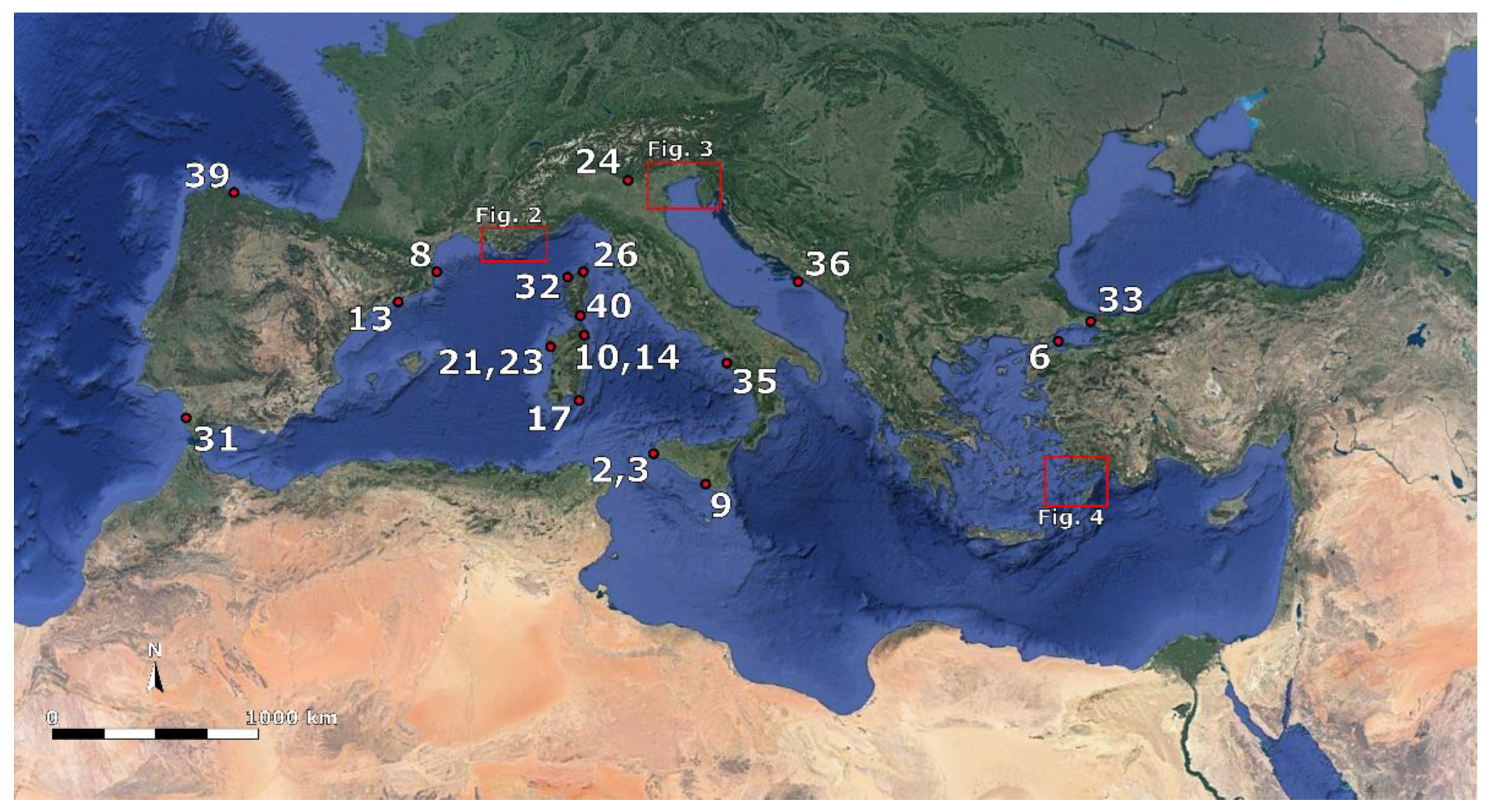

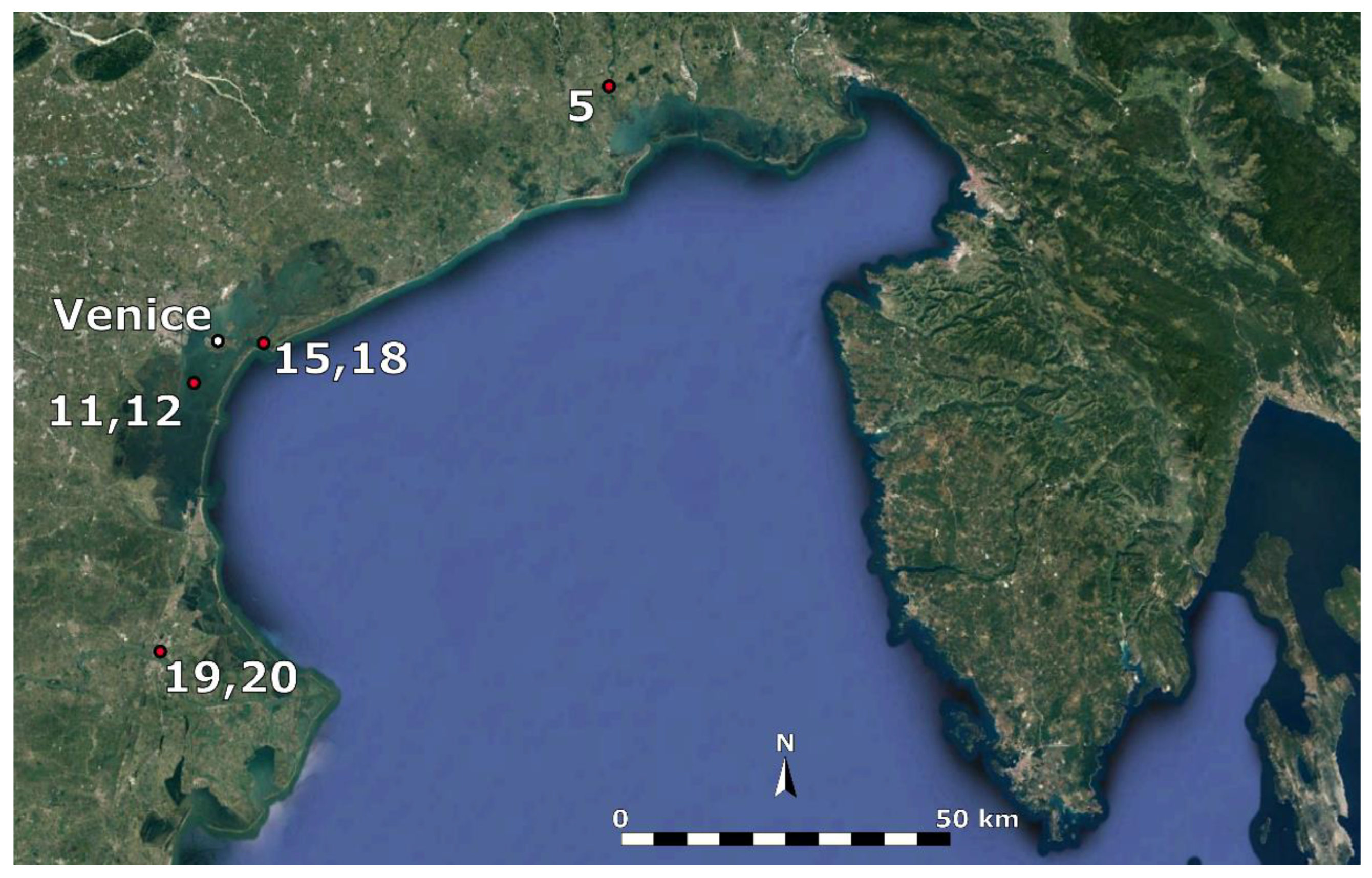
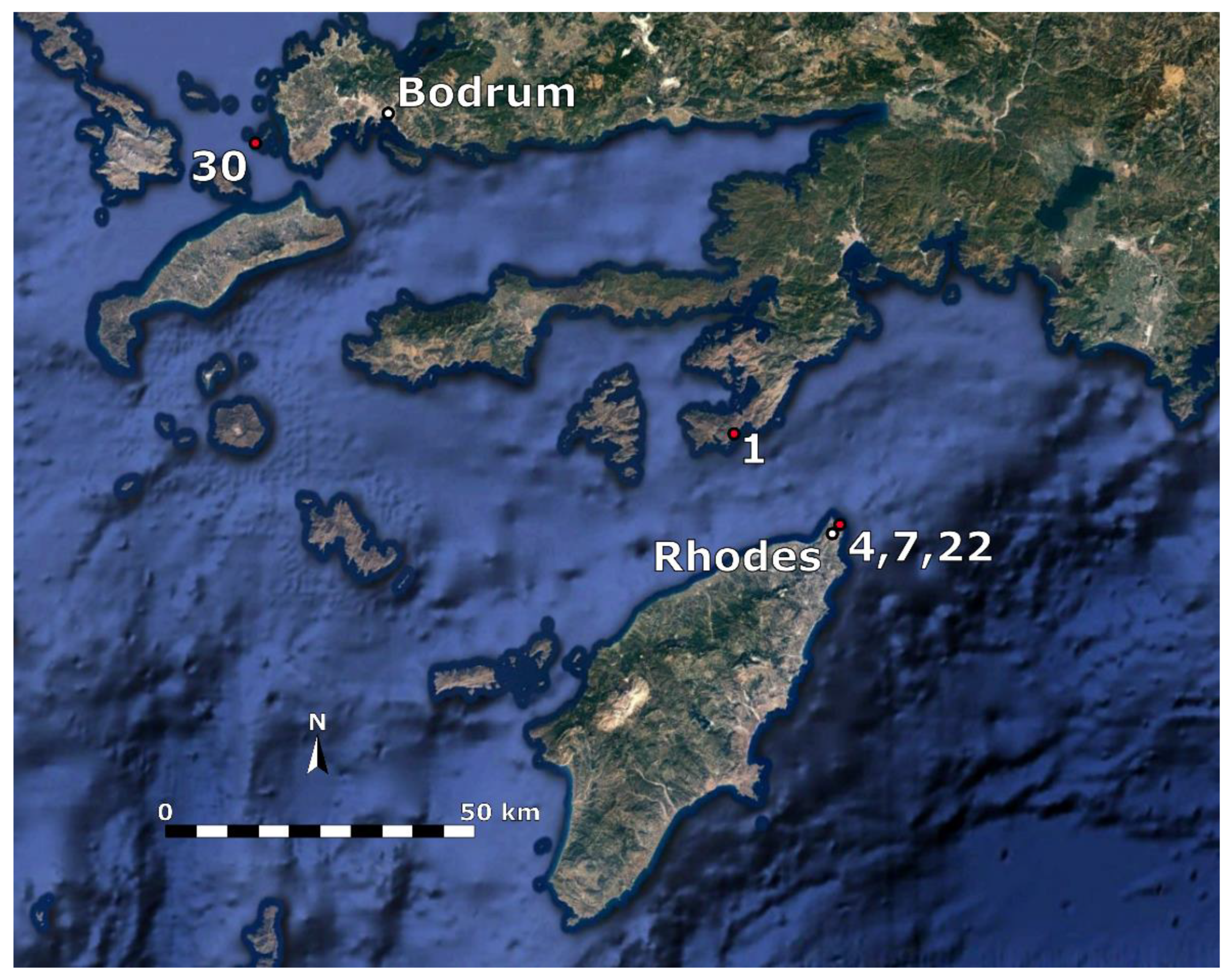
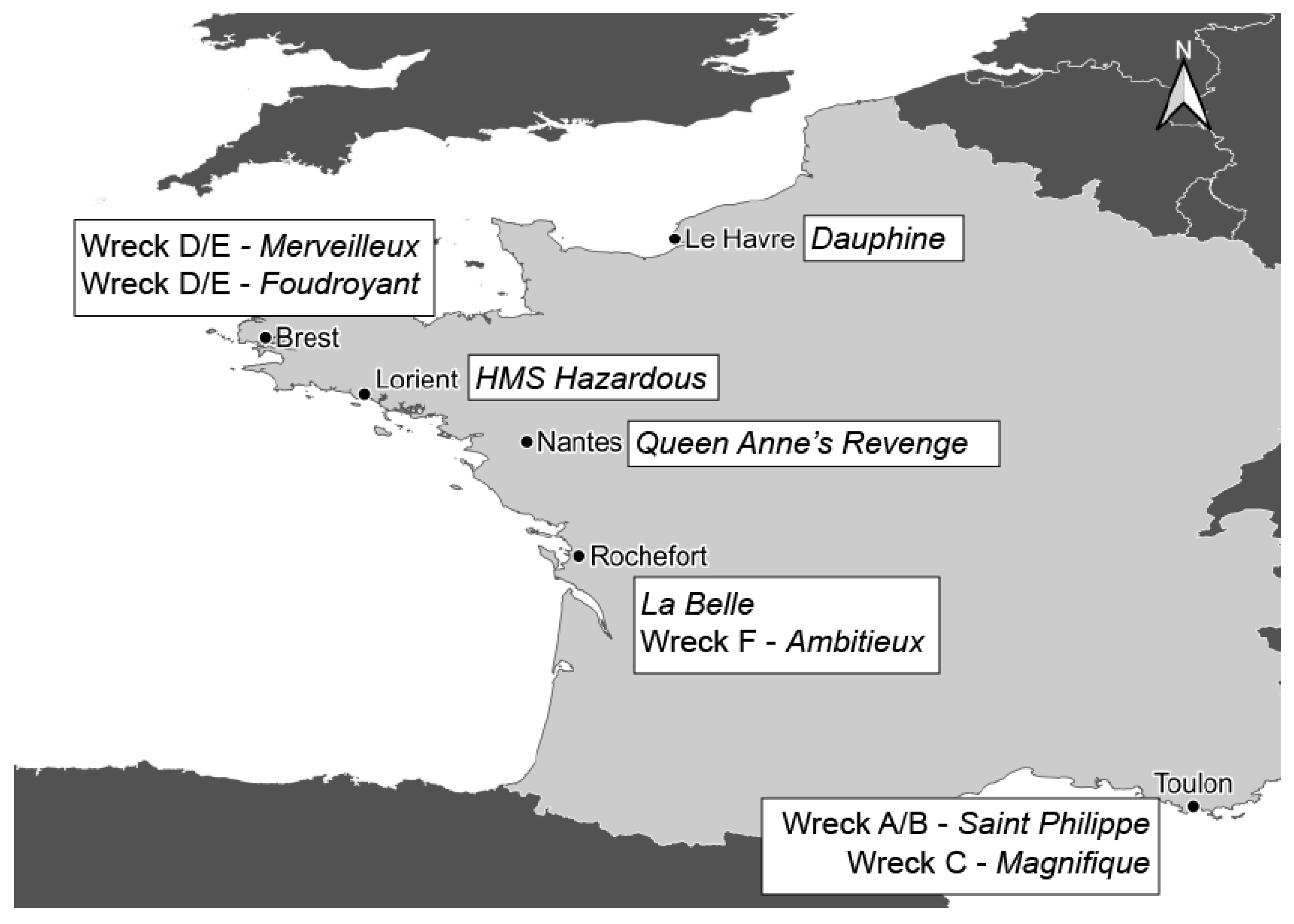
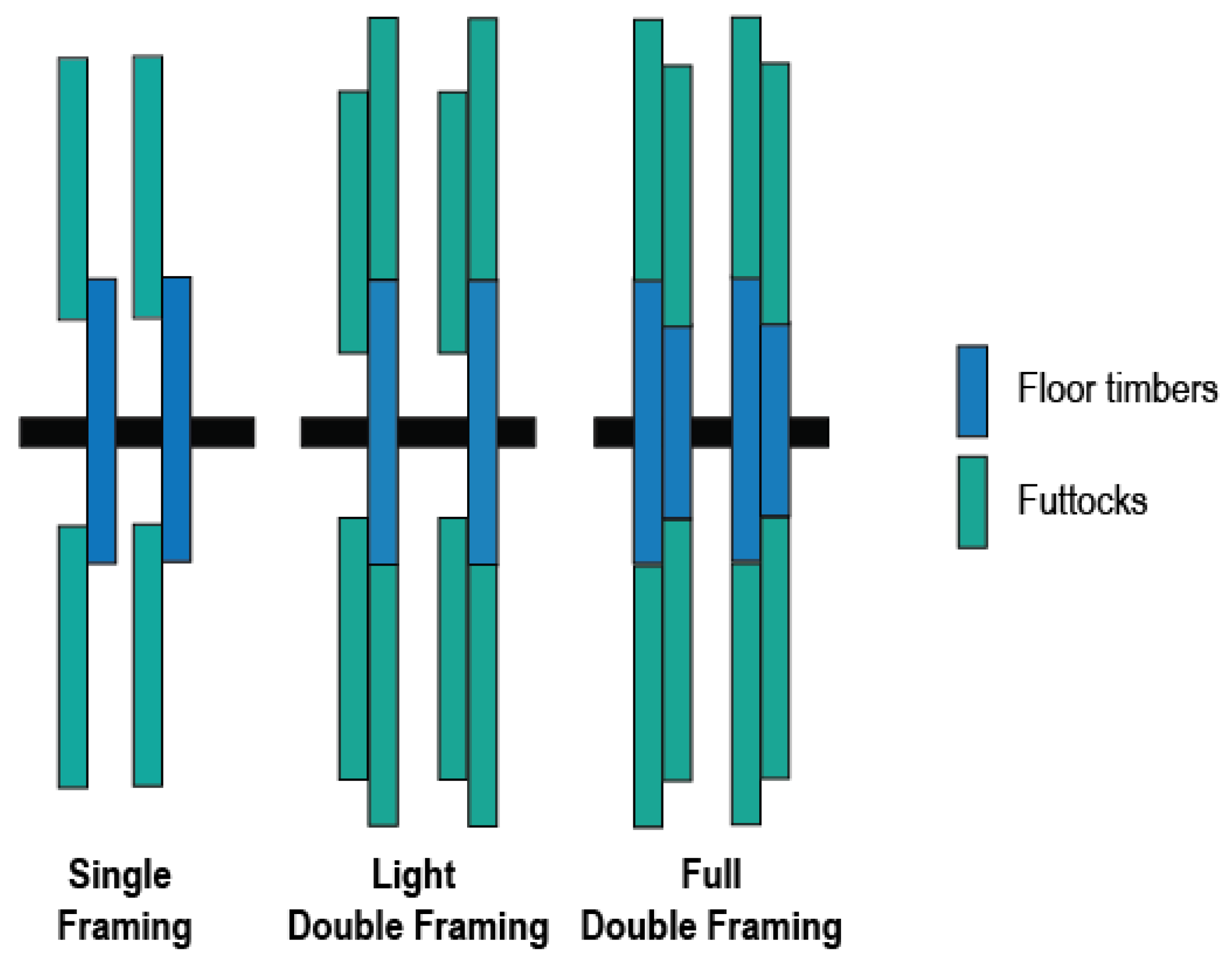
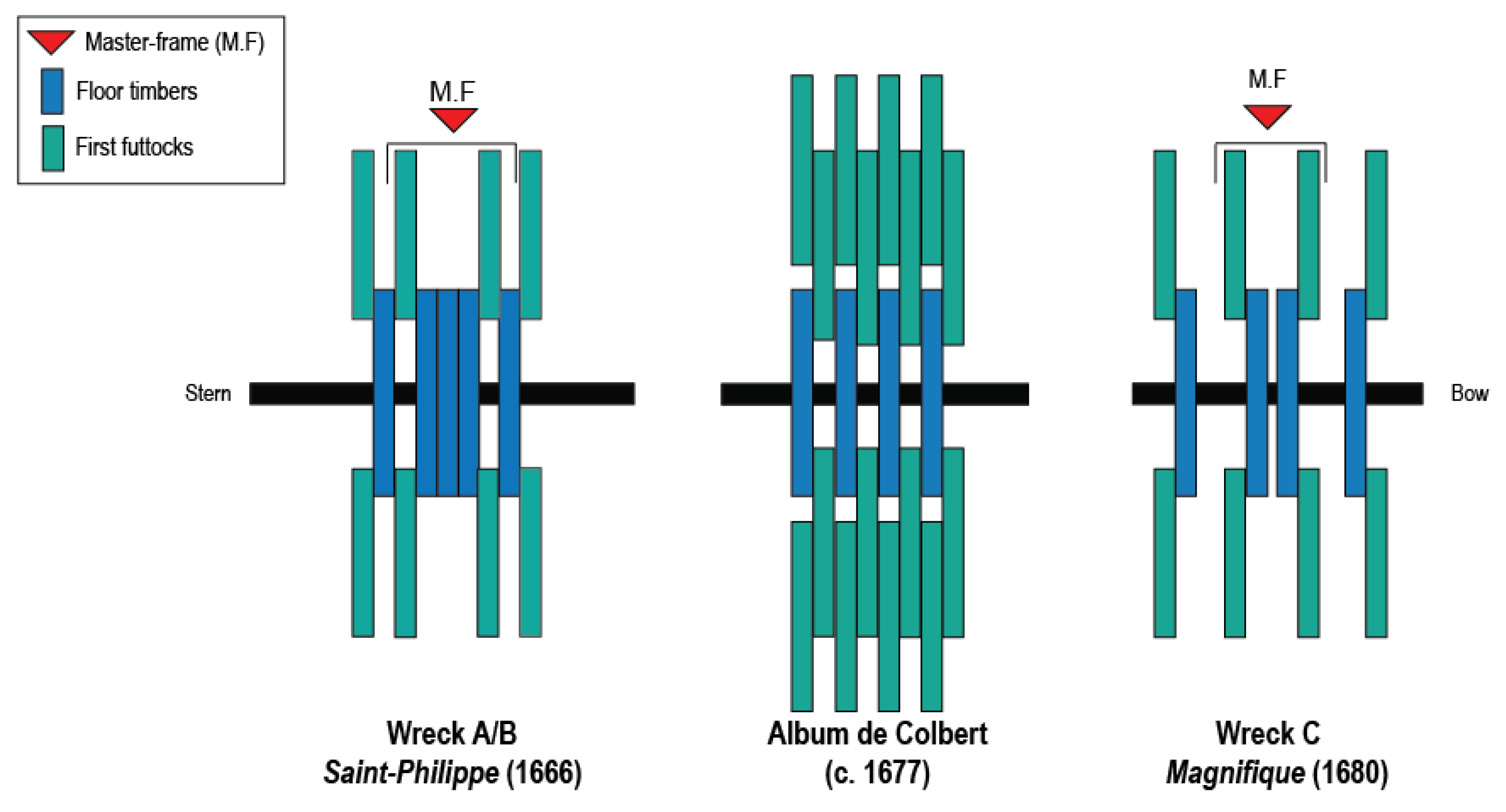
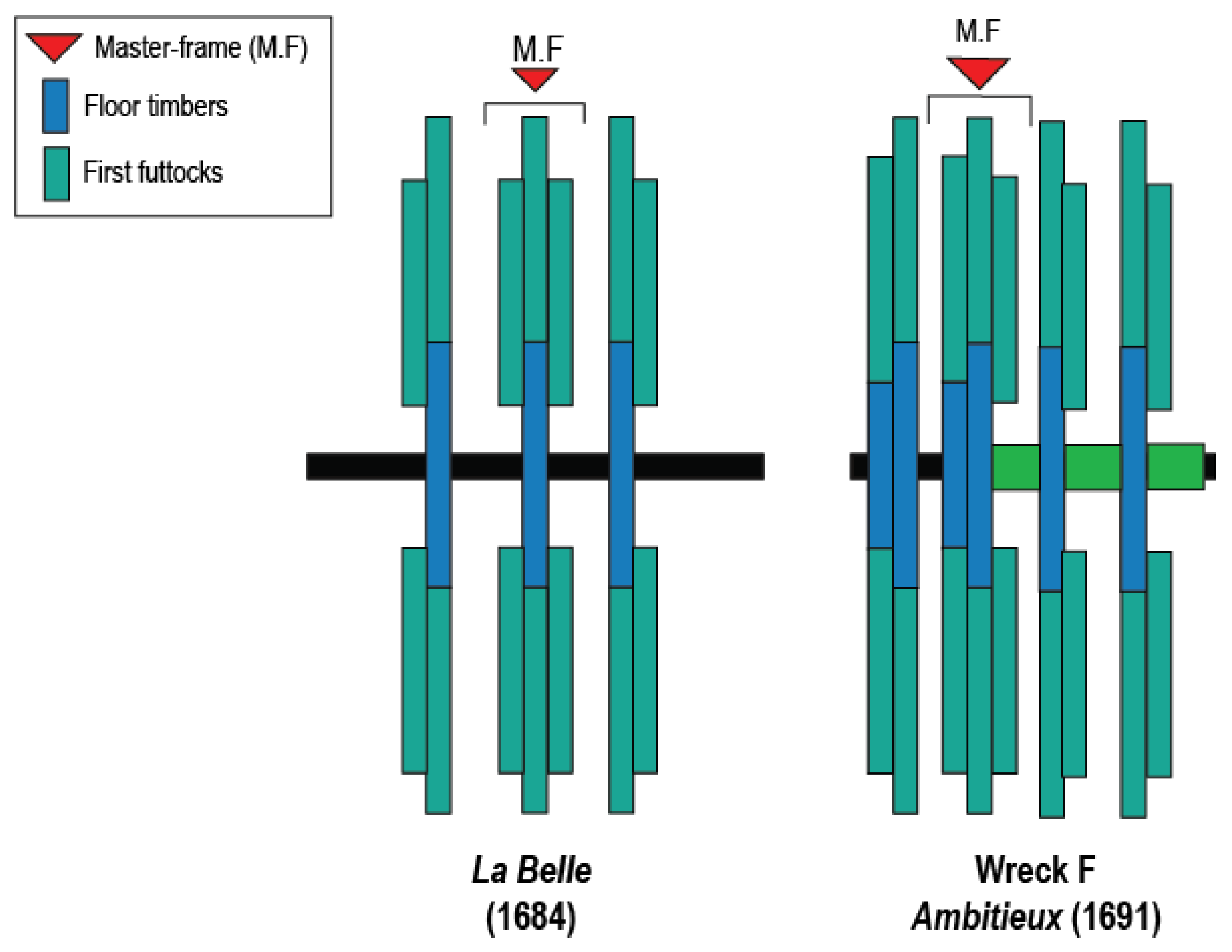

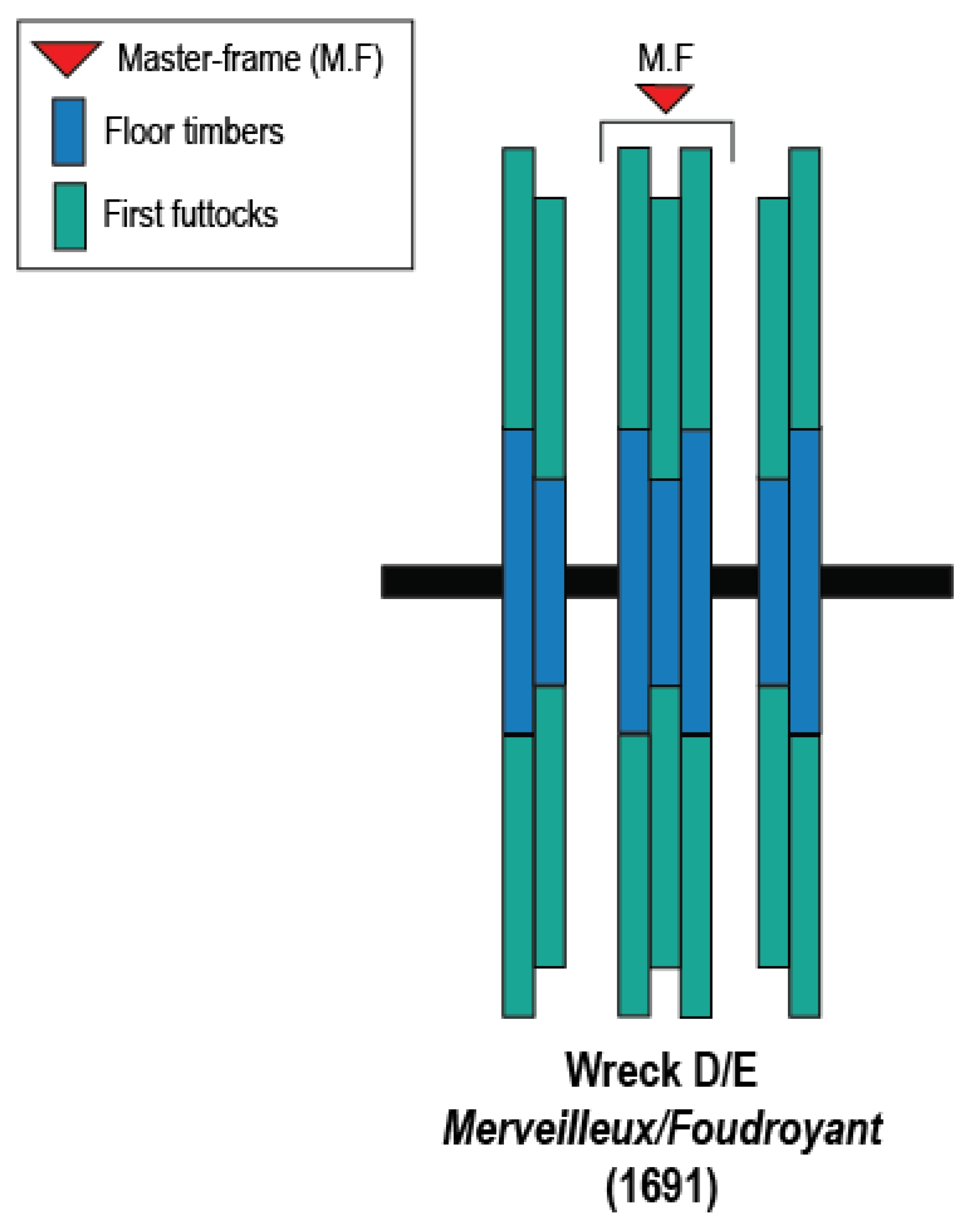

| (#) 1 Shipwreck [#] 2 | Date | LOA (m) | Beam (m) | Depth (m) | Ratio 3 | Cross-Section Amidship |
|---|---|---|---|---|---|---|
| (1) Serçe Limanı [45] | 1025 | 15.66 | 5.2 | 2.4 | 3.01 | FFT 4, hard chine 72° flair outward |
| (2) Marsala A [68,69] | 1050s | 18 | 5.8 | 2.9 | 3.1 | Slight deadrise, round bilge |
| (3) Marsala B [68] | 1100s | 8.4 | 2.8 | 1.4 | 3 | FFT, hard chine 72° flair outward |
| (4) Rhodes 4 [70] | 1175–1200s | 30–35 | FFT, hard chine 71–72° flair outward | |||
| (5) Precenicco [71] | 1180–1300 | 8 | 1.6 | 5 | FFT, soft chine flair outward | |
| (6) Çamaltı Burnu I [72] | 1200–1225 | 25 | 8 | 3.1 | FFT, unknown bilge | |
| (7) Rhodes 1 [73] | 1240 ± 60 | 20+ | FFT, round bilge | |||
| (8) Culip VI [74] | 1290–1300 | 18.8 | 4.8 | 2.2 | 3.92 | FFT, round bilge |
| (9) Camarina [75] | 13th ca. (1301?) | 30 | 4 | 7.5 | FFT, round bilge | |
| (10) Olbia Wreck 4 [76] | 1323 (?) | 9.5+ | 3+ | 3.1+ | FFT, round bilge? | |
| (11) Boccalama A [77] | 1300–1325 | 23.6 | 6 | 0.74 | 3.9 | FFT, hard chine |
| (12) Boccalama B [77] | 1300–1325 | 38 | 5 | 7.6 | FFT, round bilge | |
| (13) Les Sorres X [78] | 1390s | 9.5 | 1.9 | 0.9 | 5 | FFT, slight round bilge |
| (14) Olbia Wreck 10 [76] | 1405–1440 | FFT, round bilge (?) | ||||
| (15) Bacàn 2 [79] | 1420s | 15–16 | FFT, round bilge | |||
| (16) Marinières [80] | 1420–1430 | 25 | 8.45 | 2.07 | 3 | FFT, round bilge |
| (17) Cavoli [81] | 1440s | Limited Hull Remains | ||||
| (18) Bacàn 1 [82] | 1450s | 15–16 | FFT, round bilge | |||
| (19) Contarina I [83] | 1460s | 20.98 | 5.2 | 2.46 | 4.05 | FFT, round bilge |
| (20) Contarina II [83] | 1475s | 20.5 | 6.3 | 1.67 | 3.25 | FFT, round bilge |
| (21) Mariposa A [84] | 1475–1525 | 16.8 (25) | 4.5 (9) | 14.15 | FFT, round bilge (?) | |
| (22) Rhodes 2 [73] | 1480 or 1522 | Unknown | ||||
| (23) Mariposa B [85] | 1500–1525 | 16 | Slight deadrise, round bilge | |||
| (24) Lazise [86] | 1509 | 39.6 | 4.9 | 8.08 | FFT, round bilge | |
| (25) Villafranche [87] | 1516 | 46.45 | 14 | 4.4 | 3.32 | Half-Circle - deadrise 35 cm |
| (26) Mortella III [88] | 1527 | 36.8 | 10.5 | 6.15 | 3.5 | Half-Circle - deadrise 33 cm |
| (27) Sardinaux [89] | 1500–1550 (1540s?) | 10–12 | ~1.8 | 5 | FFT, round bilge | |
| (28) Chrétienne K [90] | 1500–1550 (1540s?) | 20–30 | FFT, round bilge | |||
| (29) West Turtle Shoals [91] | 1550–1600 | FFT, round bilge (?) | ||||
| (30) Yassi Ada 3 [92] | 1572+ | 21.2 | 6 | 1.2 | 3.53 | FFT, round bilge |
| (31) Cadiz-Delta II [93] | 1573 (1587) | 30 | (Half-Circle?) | |||
| (32) Calvi I [94,95,96] | 1575 | 23.4 | 7.8 | 2.2 | 3 | Half-Circle - deadrise 39 cm |
| (33) Kadırga [97] | 1575–1625 | 39.57 | 5.72 | 1.34 | 6.92 | FFT (slight deadrise), round bilge |
| (34) Cap Lardier 1 [98] | 1575–1600 | 20 ± 2 | FFT, round bilge | |||
| (35) Agropoli [99] | 1575–1625 | 23 | 5.75 | ~ 4 | FFT, round bilge | |
| (36) Sveti Pavao [100] | 1580 | 24 | 6+ | 4+ | FFT, round bilge | |
| (37) Church Rocks [101] | 1582+ | Unknown | ||||
| (38) Kinnagoe Bay [102] | 1588 | Flat floor-timbers, round bilge (?) | ||||
| (39) Ribadeo [103] | 1590 (1597) | 34.48 | 11.78 | 7.76 | 4.49 | (Half-Circle?) |
| (40) Rodinara [104] | 1590–1620 | 14 | 4.5 | 2 | 3.11 | FFT, round bilge (?) |
| (41) Saint-Honorat 1 [105] | 1637 | 25–30 | Shallow wineglass (?) |
| Ship | Construction Date | Shipyard | Shipwright |
| La Belle | 1684 | Rochefort | |
| Wreck A/B: Le St-Philippe | 1665 | Toulon | Gédéon Rodolphe |
| Wreck C: Le Magnifique | 1680 | Toulon | François Chapelle |
| Wreck D or E: Le Merveilleux | 1691 | Brest | Blaise Pangalo |
| Wreck D or E: Le Foudroyant | 1691 | Brest | Blaise Pangalo |
| Wreck F: L’Ambitieux | 1691 | Rochefort | Honoré Malet |
| Hazardous | 1701 | Lorient | |
| La Dauphine | 1703 | Le Havre | |
| Queen Anne’s Revenge | post 1710 | Nantes |
| Table 1667. | Author | Year |
| Hydrographie contenant la théorie et la pratique de toutes les parties de la navigation | George Fournier | 1667 |
| Album de Colbert | Unknown | 1677 |
| Proportions d’un vaisseau de 5e rang | François Coulomb | 1683 |
| Livre de construction contenant les proportions de châque rang de navire comme aussy les proportions de la masture, manneuvres, canon, les noms de tous les vaisseaux du Roy tant de ponant que de levant | François Coulomb | 1686 |
| Construction des vaisseaux du roy et le nom de toutes les pièces qui y entrent | Unknown | 1691 |
| L’architecture navale avec le routier des Indes orientales et occidentales | Charles Dassié | 1695 |
Disclaimer/Publisher’s Note: The statements, opinions and data contained in all publications are solely those of the individual author(s) and contributor(s) and not of MDPI and/or the editor(s). MDPI and/or the editor(s) disclaim responsibility for any injury to people or property resulting from any ideas, methods, instructions or products referred to in the content. |
© 2023 by the authors. Licensee MDPI, Basel, Switzerland. This article is an open access article distributed under the terms and conditions of the Creative Commons Attribution (CC BY) license (https://creativecommons.org/licenses/by/4.0/).
Share and Cite
Bendig, C.D.; Gauthier-Bérubé, M. Agency and Structure in Shipbuilding: Practice and Social Learning Perspectives. Heritage 2023, 6, 1444-1475. https://doi.org/10.3390/heritage6020079
Bendig CD, Gauthier-Bérubé M. Agency and Structure in Shipbuilding: Practice and Social Learning Perspectives. Heritage. 2023; 6(2):1444-1475. https://doi.org/10.3390/heritage6020079
Chicago/Turabian StyleBendig, Charles D., and Marijo Gauthier-Bérubé. 2023. "Agency and Structure in Shipbuilding: Practice and Social Learning Perspectives" Heritage 6, no. 2: 1444-1475. https://doi.org/10.3390/heritage6020079
APA StyleBendig, C. D., & Gauthier-Bérubé, M. (2023). Agency and Structure in Shipbuilding: Practice and Social Learning Perspectives. Heritage, 6(2), 1444-1475. https://doi.org/10.3390/heritage6020079







